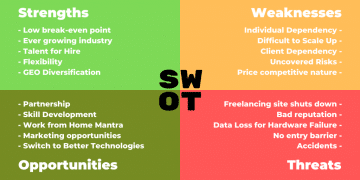As a small business or an individual freelancer, how to calculate the break-even point for software development services business

If you don’t know your break-even point, you don’t know your business, and you are doing it all wrong. So let us understand the break-even point in doing an effortless and yet effective way to calculate the break-even point.
What is the Break-Even Point?
The break-even point is when the total expense (fixed expense + variable expense) is less than or equal to the amount of revenue generated from operations in the given period.
Usually, the time for such calculation in small software development services companies is monthly. However, for large organizations, it is either for a quarter or even for the whole financial year as well.
So a break-even month is when the total income in a month less than the overall expense in the same month.
Similarly, a break-even quarter is when the total income in the quarter less than the total expense in the same quarter.
Expenses for the Break-Even Point Calculation
So how you calculate the break-even point for a web development company?
- Estimate all the fixed costs. (i.e., rent, Internet charges, etc.)
- Estimate all the variable costs (i.e., salary, electricity, etc.)
Now add both to get the total expenses.
Income For the Break-Even Point Calculation
For a small software services company, the calculation of revenue can be different:
- When the project’s kick-off – Let’s assume a project started in May. As the project began, one can add the total revenue of the project in May. You may or may not end-up completing the project in the money of may. However, the income is considered in May.
- When the project finishes – The Delivery of a project is done in August, so one adds the total revenue of the project in August and not in May.
- When clients make a payment for the project – As soon as the client makes the payment, you add it to the revenue for the month and not when it started or finished. If the client pays in parts, you add the amount as revenue.
All the above calculations work fine for small projects in small companies. However, none of them is used for larger companies. Ideally, estimates are for the work done on a project in a period, along with the associated expenses.
So if a project started in May and completed 40% in June, 40% of the total project’s revenue value should be added in June’s revenue. Estimating 40% of work is complete in a month can be tough for smaller companies. So one can use the more natural option for the sake of calculations.
As one grows, one can adopt a more accurate method of calculation. However, as a small Software Development Services company willing to calculate the break-even point, one can use the not so efficient ways to calculate the income as well as the expenses.
Final Thoughts
Once the company generates revenue equal to the total expenses, it is the break-even point.
If you don’t know your break-even point, you don’t know your business, and you are doing it all wrong. Even today, I know my break-even point and what’s the minimum I need to earn in a month to break even and often the bare minimum earning happen in the first week of the month itself.

